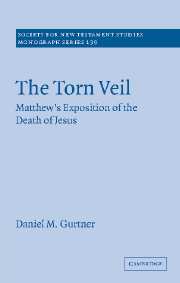Book contents
- Frontmatter
- Contents
- Preface
- List of abbreviations
- 1 Introduction
- 2 Veils in the Old Testament
- 3 Functionality and Identity of the ‘Veil of the Temple’
- 4 The Veil in Second Temple and Rabbinic Judaism
- 5 Matthew's Temple and Jesus' Death: Hermeneutical Keys to the Rending of the Veil
- 6 Analysis of the Matthean Velum Scissum Pericope
- Conclusion: Matthew's velum scissum – Retrospect and Prospect
- Diagram: Veil Language in the Structure of the Tabernacle
- Appendix 1 Veil Language in the Old Testament
- Appendix 2 Veil Language in the Two Tabernacle Accounts
- Appendix 3 Kαταπέτασμα and the חכרפ
- Bibliography
- Index of Texts
- Index of Select Subjects
- Index of Modern Authors
- Index of Select Terms
5 - Matthew's Temple and Jesus' Death: Hermeneutical Keys to the Rending of the Veil
Published online by Cambridge University Press: 22 September 2009
- Frontmatter
- Contents
- Preface
- List of abbreviations
- 1 Introduction
- 2 Veils in the Old Testament
- 3 Functionality and Identity of the ‘Veil of the Temple’
- 4 The Veil in Second Temple and Rabbinic Judaism
- 5 Matthew's Temple and Jesus' Death: Hermeneutical Keys to the Rending of the Veil
- 6 Analysis of the Matthean Velum Scissum Pericope
- Conclusion: Matthew's velum scissum – Retrospect and Prospect
- Diagram: Veil Language in the Structure of the Tabernacle
- Appendix 1 Veil Language in the Old Testament
- Appendix 2 Veil Language in the Two Tabernacle Accounts
- Appendix 3 Kαταπέτασμα and the חכרפ
- Bibliography
- Index of Texts
- Index of Select Subjects
- Index of Modern Authors
- Index of Select Terms
Summary
Introduction
As I have argued throughout, all of the analyses of Old Testament, Second Temple and rabbinic portrayals of the veil must be subjected to the Matthean text to evaluate adequately their role in a contextual interpretation of the rending of Matthew's temple veil. This, in part, is the subject of the present chapter, where I will undertake a composition-critical approach to what I have identified as two hermeneutical keys to interpreting Matthew's rending of the veil: Matthew's portrayal of the temple and his portrayal of the death of Jesus. Here I will employ a sort of hermeneutical algebra. There are three elements to this equation carefully linked by the evangelist: the tearing of the veil, the temple and the death of Jesus. I will examine Matthew's portrayal of the temple and the death of Jesus throughout the gospel (for which we have some evidence) and use these items to interpret the rending of the veil (for which we have but a single piece of evidence).
‘Composition criticism’ can be variously understood. Stanton says that it ‘considers the overall structure of each gospel, the structure of individual sections and subsections and the order in which the evangelists have placed the traditions at their disposal’. It has a ‘strong insistence that the gospels must be viewed as whole units whose various parts are interrelated’. However, this has very strong affinities with redaction criticism as it is traditionally employed.
- Type
- Chapter
- Information
- The Torn VeilMatthew's Exposition of the Death of Jesus, pp. 97 - 137Publisher: Cambridge University PressPrint publication year: 2006



